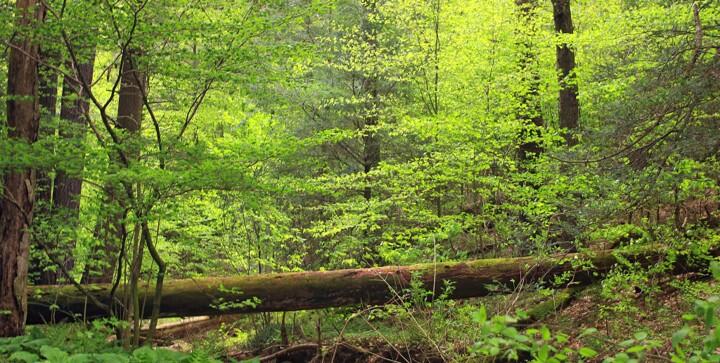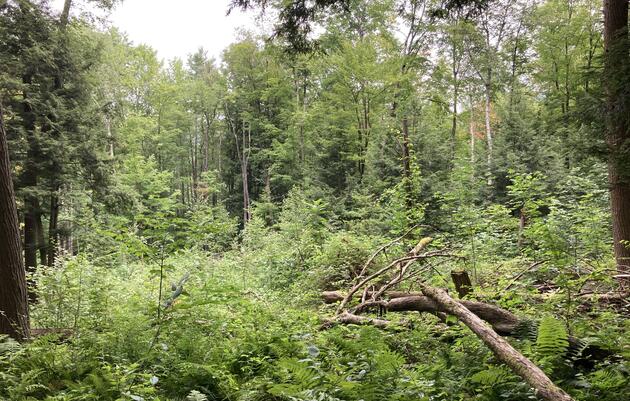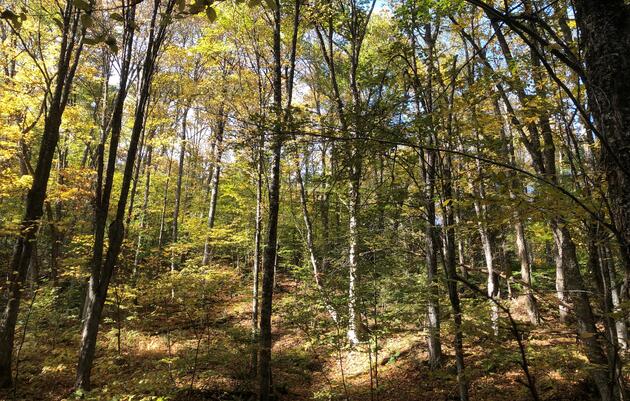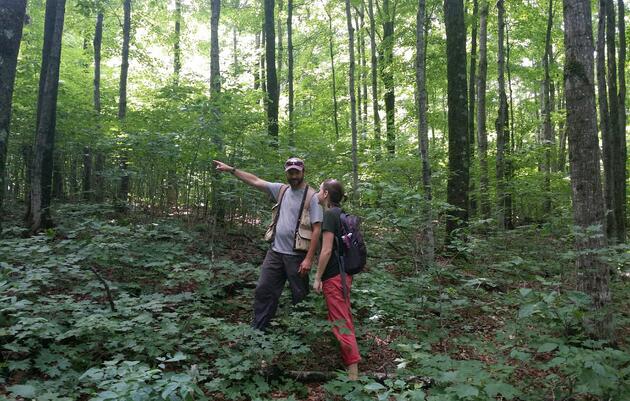“It’s complicated.”
We could leave our discussion of forest management there, to the objections of very few. For two decades, however, Audubon Vermont has advanced conservation solutions that work for all members of the forest ecosystem, from homeowners to Scarlet Tanagers. Though we might not have all the answers, the lessons we have learned along the way can contribute to a growing and urgent conversation about the future of Vermont’s forests.
This article marks the last of “Shades of Green,” a three-part series summarizing the state of Vermont’s forests and sharing Audubon Vermont’s vision for the future of forest management in the state. In part one, we highlighted the diverse benefits of Vermont’s forests for rural communities, bird populations, climate mitigation, and more. In part two, we explored the threats facing our forests, and the values that all forest management must prioritize. Now, we will integrate those values and needs into a holistic forest management strategy capable of balancing forest health, diversity, and productivity for generations to come.
Balance is possible—and is already happening across Vermont’s forests. Audubon Vermont’s Foresters for the Birds program helps foresters throughout the state manage working forests for timber and songbirds alike. Established in 2008 in partnership with the Vermont Department of Forests, Parks, and Recreation (FPR), Foresters for the Birds offers workshops, demonstration sites, project consultations, and a series of guides to integrating timber and songbird management (see Silviculture with Birds in Mind, Birds with Silviculture in Mind, and Forest Bird Habitat Assessment). Woods, Wildlife and Warblers, a project that provides property assessments and other support to private forestland owners; the Bird-Friendly Maple Project, which promotes habitat management in Vermont’s sugarbushes; and the Audubon Forester Training and Endorsement Program round out Audubon Vermont’s efforts to preserve a place for Eastern Wood-Pewees, Yellow-bellied Sapsuckers, Chestnut-sided Warblers, and other avian marvels in the future of Vermont forests.
Though managing forests for both people and birds might at first seem contradictory, there is compatibility between their needs: birds and people have the same needs. Audubon Vermont’s programs leverage this fact to create an interspecies forest exchange, coordinating the demands of people and birds—people for forest products, birds for varied habitat—to supply one another. Strategically harvesting wood from forests dominated by secondary growth can simultaneously restore ecological complexity to Vermont forests and provide sustainable wood to Vermont communities, creating a win-win-win solution for birds, local economies, and wood consumers across the state. (To learn more about the co-benefits of active forest management, read this article by Audubon Vermont executive director David Mears.)
When it comes to slowing and responding to the effects of climate change, active forest management can again be an important tool in the conservation toolbox. Older forests support larger trees and store more carbon. For that reason, allowing forests to grow old without human interference, a strategy known as passive management is one essential tactic to offsetting our carbon emissions. As the Vermont Department of Forest Parks and Recreation notes in its 2021 Vermont Forest Carbon Inventory, however, total area, not age, is the most important factor in Vermont forests’ climate mitigation potential. As part of a broader management strategy, sustainable timber harvests promote the economic viability of the forest industry, protecting our forests from development and preserving their carbon benefits.
Prohibiting all types of harvesting in all forests would surrender the benefits of strategic, ecologically focused management to people, wildlife, and even our climate goals. Audubon Vermont’s decade-long collaboration with the Northern Institiute of Applied Climate Science and the Department of Forests Parks and Recreation has revealed that bird-friendly forestry is compatible with climate-smart forestry—in fact, their management practices largely overlap. Both approaches promote ecological forestry, which emulates natural disturbance patterns to restore a diversity of young- and old-growth forest conditions to the landscape. In addition to its benefits for wildlife habitat, landscape complexity improves forests' adaptability to climate change by offering safe passage and shady refuge to species in newly inhospitable environments. As the University of Vermont researchers note in a 2022 study, applying a climate adaptation lens to the trade-offs between carbon and wildlife empowers forest managers to maintain a diverse set of strategies at the landscape scale, “hedging our bets in an uncertain future” (Littlefield & D’Amato 2022). Ecological forestry can thus reinforce our climate goals, marking yet another ‘win’ for a proactive, inclusive approach to forest management in Vermont. (To learn more about ecological forestry, watch this presentation by University of Vermont professor and Forestry Program director, Tony D’Amato.)
To serve our diverse needs today and anticipate new and changing needs tomorrow, effective forest conservation requires a constellation of management strategies. This reality prompts yet another difficult set of questions: How should we distribute these strategies across the landscape? Which lands should be preserved for true old-growth forests, and which should be actively managed for old-growth characteristics, timber, and wildlife habitat?
Noting that activities on public lands can be more strongly regulated, some view these areas as an ideal setting for passive management, sometimes referred to as “proforestation.” They reason that, since only one-fifth of Vermont forestland is public, the forest industry could survive a ban on timber harvesting in state and federal forests. This line of argument risks perpetuating a misconception that active forest management involves the reckless clear-cutting of our forests. Ecological forestry, however, secures critical environmental benefits that passive management alone cannot, making it equally worthy of implementation on public lands. The argument also overlooks a vital function of public forestland—as a tool for demonstrating effective forest management, done with the oversight of state or federal forest officials.
As noted in part 1 of this series, seventy-nine percent of Vermont’s forestland is privately owned. We can use timber harvests on public land to using ecological forestry practices, such as Audubon Vermont encourages, to educate loggers, foresters and private forest landowners. Our public lands can reflect the diversity of management strategies that we aspire to replicate across the state. Finally, creating a landscape-wide mosaic of forest types and uses, across both privately- and publicly-owned forestland ensures that all Vermonters can access and enjoy the diverse benefits of our forests.
To conserve Vermont’s forests, perhaps the best solution is also the most intuitive: listen to message of complexity that resonates throughout the forests themselves. Just as complex forests support diverse wildlife, complex management strategies can support our diverse values. Aldo Leopold, an influential American forester and ecologist of the early 20th century, once said, “The first law of intelligent tinkering is to save all the parts.” Applied to forests, the parts might include the trees themselves, but also the wildlife that inhabits them, the carbon they store, and the people and communities they serve. When we sacrifice any one of these parts in pursuit of another, we put our forest ecosystems at risk.
We are too late to do nothing. To restore our forests, some tinkering is required. To tinker intelligently, however, requires the humility to accept that our forests and all their components including birds and wildlife, trees, water, soils, and human communities are connected in more ways than we can know. By maintaining a diverse portfolio of management strategies to apply across the landscape, and by continuing to study, listen and learn, we can give the forests the time and room to tell us what they need.
This conversation attracts strong and sometimes conflicting opinions from even the most renowned forest ecologists in the Northeast. To learn more about these various perspectives, we encourage you to watch “Exploring Conservation and Proforestation Options for NJ Forests,” a panel discussion organized by the New Jersey Forest Task Force in 2022.
We are grateful to policy intern Thomas Patti for his work on this series and acknowledge his significant contributions!











